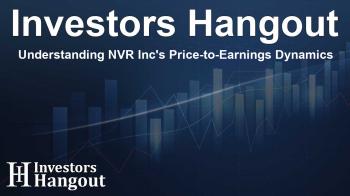Understanding NVR Inc's Price-to-Earnings Dynamics

Delving Into NVR Inc's Financial Performance
Currently, NVR Inc. (NYSE: NVR) shares are trading at $8143.15, reflecting a slight decrease of 0.44%. Over the past month, the stock price has decreased by 9.07%, while there’s a notable increase of 17.37% over the past year. This mixed short-term performance amidst a robust long-term growth trend prompts long-term shareholders to examine the company's price-to-earnings (P/E) ratio closely.
Understanding the P/E Ratio and Its Significance
The price-to-earnings (P/E) ratio is a vital metric for investors who seek to evaluate a company's market performance against industry standards and historical earnings. A lower P/E ratio may suggest that shareholders have subdued expectations regarding the stock's future growth, or it may imply that the company is undervalued in the market.
Comparing NVR's P/E with Industry Peers
In comparison to the collective P/E ratio of 12.64 in the Household Durables sector, NVR Inc. currently displays a P/E ratio of 16.74. This discrepancy suggests that investors might harbor higher expectations for NVR's future performance relative to its industry peers, yet it also raises concerns that the stock could be perceived as overvalued, as seen by looking at relative performance metrics.
Interpreting the P/E Ratio: Limitations and Context
While the P/E ratio is an essential tool for gauging market performance, it is crucial to acknowledge its limitations. A lower P/E may indicate undervaluation, but it could also signify a lack of optimism about the company's growth potential. Investors should not rely solely on the P/E ratio; it's essential to look at broader industry trends and economic cycles that affect stock pricing.
Practical Implications for Investors
When using the P/E ratio in investment decision-making, it is advisable for shareholders to complement this analysis with other financial metrics and qualitative factors. Determining a holistic view of NVR Inc., considering market conditions, earnings reports, and competitive positioning, allows investors to make more informed and strategic choices.
Frequently Asked Questions
What does P/E ratio indicate about a stock?
The P/E ratio provides insight into how much investors are willing to pay per dollar of earnings, indicating market expectations about a company's future growth.
How does NVR's P/E compare to its industry?
NVR's P/E of 16.74 is higher than the industry average of 12.64, suggesting that investors may expect better future performance.
Why is P/E ratio important for investors?
The P/E ratio helps investors assess whether a stock is undervalued or overvalued compared to its earnings potential and industry standards.
Can P/E ratio be used independently for investment decisions?
No, while valuable, the P/E ratio should be used alongside other financial metrics and qualitative analyses for thorough investment decision-making.
What factors can affect a company's P/E ratio?
Industry trends, macroeconomic conditions, company performance, and overall market sentiment can all influence a company's P/E ratio.
About Investors Hangout
Investors Hangout is a leading online stock forum for financial discussion and learning, offering a wide range of free tools and resources. It draws in traders of all levels, who exchange market knowledge, investigate trading tactics, and keep an eye on industry developments in real time. Featuring financial articles, stock message boards, quotes, charts, company profiles, and live news updates. Through cooperative learning and a wealth of informational resources, it helps users from novices creating their first portfolios to experts honing their techniques. Join Investors Hangout today: https://investorshangout.com/
Disclaimer: The content of this article is solely for general informational purposes only; it does not represent legal, financial, or investment advice. Investors Hangout does not offer financial advice; the author is not a licensed financial advisor. Consult a qualified advisor before making any financial or investment decisions based on this article. The author's interpretation of publicly available data shapes the opinions presented here; as a result, they should not be taken as advice to purchase, sell, or hold any securities mentioned or any other investments. The author does not guarantee the accuracy, completeness, or timeliness of any material, providing it "as is." Information and market conditions may change; past performance is not indicative of future outcomes. If any of the material offered here is inaccurate, please contact us for corrections.
